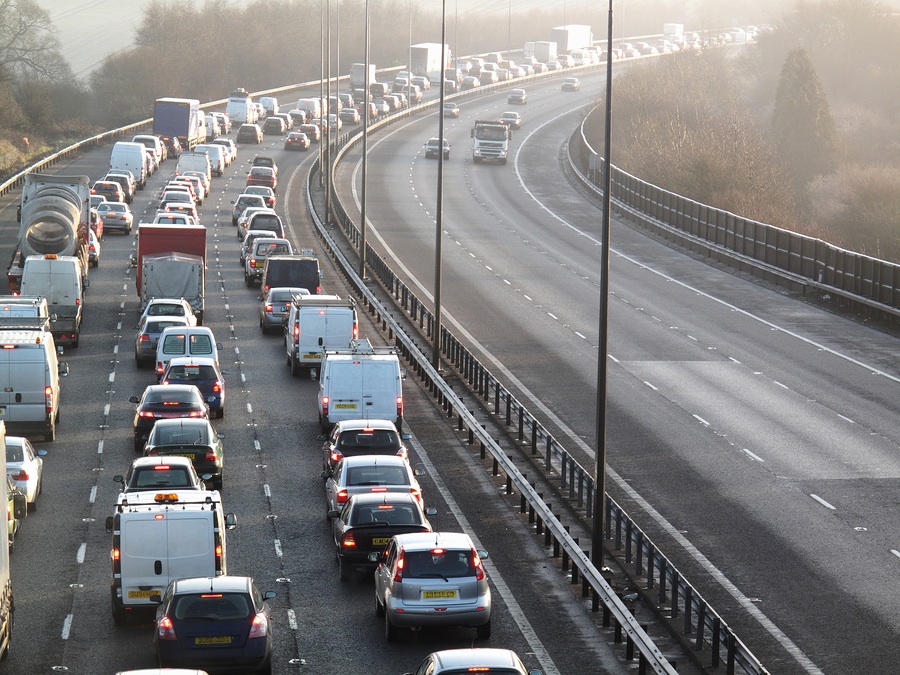Secondary Incidents:
Assessing the Effectiveness of Safety Service Patrols
The logic seems clear: Mitigating the impact of accidents and incidents would seem to reduce secondary accidents and incidents, but how do we really know this? And, just how effective are Safety Service Patrols in reducing secondary accidents? To answer these questions, we turn to those who have measured cost benefits of Safety Service Patrols to see how the “prevention of an occurrence” is treated.
Benefits of Safety Service Patrols
According to Lance Dougald of the Virginia Transportation Research Council: “Virginian taxpayers’ investment in these Safety Service Patrols pays a five-fold return not just in cost, but also in congestion reduction, customer service improvements and safety enhancements. The Safety Service Patrols also help prevent secondary accidents, saving additional delays and saving lives.” Dougald’s statement is based on a cost-benefit analysis that the Virginia DOT performed to examine the benefits of one of its service patrol programs.1
Similarly, a study of Florida’s Road Ranger patrol program found that “the benefit-cost ratio of the entire Road Ranger program is estimated to be in excess of 25:1.”2 These benefits are measured in terms of “reduced delays, fuel consumption, air pollution, increased safety, and security.”
In a study performed by Gang-Len Chang of the University of Maryland, secondary incident research was based on a static threshold; that is an incident occurring within a specific time after a primary incident, and within a certain distance of the primary incident.4 The variables were expected to change depending on location, weather, season, etc..
Based on these standards, the study found that there was a 28.71% reduction of primary incident duration due to Safety Service Patrols and emergency services response, which would theoretically result in the reduction of secondary incidents. However, this result is theoretical, and does not provide a clear picture of how secondary incidents are truly affected by Safety Service Patrols.
Despite the published success of these examples, the vast majority of organizations could not quantify the benefits of their service patrols directly in terms of the reduction of secondary incidents. Paul Jodoin, Traffic Incident Management Program Manager, of the FHWA Office of Transportation Emergency Transportation Operations Traffic Incident Management Team explained: “We don’t have any definitive numbers on the topic. The assumption exists that service patrols can help with reducing secondary incidents because one of their duties, for most service patrols, but not all, is to provide traffic control, and the better the traffic control, the more apt you are to reduce secondary incidents. Safety Service Patrols by the nature of their role are often in a position to arrive at an incident scene quickly to enable early safety protection and traffic control which helps to prevent another related incident.”
The FHWA also noted that its self-assessment tool showed that in 2009 less than 10% of the TIM respondents were able to accurately track the performance of TIM teams in reducing secondary incidents. 3 Safety Service Patrols are a subset of these TIM Teams. Part of the problem was finding a precise definition of ‘secondary incidents.’
Categorizing Secondary Incidents
In 2005 the FHWA established the Traffic Incident Management Performance Measures Focus States Initiative (TIM PM FSI), eleven states which engaged to define incident management performance measures and conduct field tests. The final report published in December 2009 revealed difficulties in coming to a consensus on the precise definition of secondary accidents. While there is consensus that secondary accidents occur in proximity of time and space to a primary incident, concerns were raised that “if responders had properly handled a primary incident, the secondary incident would not have occurred; therefore, the secondary incident is the direct responsibility of the responders.”5
 Other issues discussed by participants while formulating a definition of secondary incidents included whether or not incidents that occurred during recurring congestion were secondary and specifically whether or not rear-end crashes should be filtered out in order to avoid overstatement of the number of secondary incidents.
Other issues discussed by participants while formulating a definition of secondary incidents included whether or not incidents that occurred during recurring congestion were secondary and specifically whether or not rear-end crashes should be filtered out in order to avoid overstatement of the number of secondary incidents.
Participants concluded that incidents occurring during recurring congestion were not secondary. Also, rear-end collisions that occur when a roadway is at or above capacity should not be classified as secondary incidents even if they occur within proximity of a primary accident. Only rear-end crashes that occur within proximity to a primary incident when roadways are at less than capacity would be classified as a secondary incidents.
Participants also considered the need to define time or distance metrics in relation to the primary incident and the need to provide training to incident responders on how to identify a secondary incident. While the time or distance was not defined, one state suggested that secondary incidents “are defined as incidents that occur within 2 miles and/or 2 hours of a primary incident. The State also indicated that incidents occurring within one-half mile and/or one-half hour of a primary crash in the opposite direction are also considered secondary.”6 This suggestion, however, was never agreed upon entirely. All states did agree, however, that training of first responders would be necessary in order to secure accurate categorization of secondary incidents.
After these careful considerations, the eleven states agreed upon the following definition:
Secondary incidents are unplanned incidents (starting at the time of detection) for which a response or intervention is taken, where a collision occurs either a) within the incident scene or b) within the queue (which could include the opposite direction) resulting from the original incidents.7
The FHWA backs this definition as the standard national definition for secondary incidents. It was determined that a follow-up study would be necessary to conduct field tests on the reduction in the number of secondary incidents.
New Methods of Categorization
According to a report by Karlaftis et al., “the likelihood of a secondary crash increases by 2.8% for each minute the primary incident continues to be a hazard.”8 In a study performed by the University of Missouri – Columbia and the Midwest Transportation Consortium, researchers have proposed a new methodology for categorizing secondary incidents.9 The researchers in this study used extensive traffic alert data from the St. Louis, Missouri area and found that the static threshold methodology mistakenly categorized up to 30% of the accidents as either false positives or false negatives. The researchers proposed a dynamic threshold that more accurately categorized incidents as primary or secondary incidents.
According to the conclusions of the study, if transportation agencies do not have exact categorization for each incident that occurs, they can “utilize the existing [progression incident] curves [i.e. parabolic-shaped curves showing the variation of queue length throughout an incident] to estimate the number of secondary accidents occurring in a given year. This information can help evaluate the safety performance of the agencies’ incident management systems or other transportation systems.” These curves can also help agencies categorize the incidents that they do have data on more accurately.
As of today, agencies still primarily rely on the static threshold model to measure the effectiveness of Traffic Incident Management teams in reducing secondary incidents. This will not likely change until the conclusion of the FHWA Traffic Incident Management (TIM) Incident-Performance Metric Adoption Campaign Study due out in October 2012. The study aims to “develop and implement an outreach, adoption and data collection program over a three-year period” and to “define issues and analyze practices for ‘Secondary Crashes’ so that these statistics may be uniformly defined and collected during the subsequent study” of the top 40 metropolitan areas and their resident states.10 The end goal of these studies is to propose an annual systematic method that will maintain these statistics and measure the effectiveness of TIM programs in the top 40 metro areas.
Once there is universal acceptance of a definition and corresponding measuring parameters, jurisdictions can apply them and compare incident reports. According to FHWA’s Paul Jodoin: “Once we get a handle on gathering data on secondary accidents in general and if it’s showing that those areas across the country with service patrols have fewer secondary accidents, then we can point our fingers at that and show a connection between the two. However, it may be years before we can identify an exact connection [between secondary incidents and Service Patrols].”
Susan Kristoff, President of The Kristoff Group, is an engineer and writer with extensive experience in transportation research and development. She can be reached at
susan@kristoffgroup.com.
1 http://vtrc.virginiadot.org/PubDetails.aspx?PubNo=07-R33
2 http://www.dot.state.fl.us/research-Center/Completed_Proj/Summary_TE/FDOT_BD544_14_rpt.pdf
3 http://www.transportation.org/sites/ntimc/docs/TIM%20SA%202009%20National%20Analysis%20Report%2012%2017%2009.pdf
4 http://chartinput.umd.edu/reports/chart2007final.pdf
5 Owens, Nicholas, et al., Federal Highway Administration Focus States Initiative: Traffic Incident Management Performance Measures Final Report, December 2009
6 ibid.
7 ibid.
8 Karlaftis, Latoski, Richards, Sinha: “ITS Impacts on Safety and Traffic Management: An Investigation of Secondary Crash Causes,” ITS Journal, 1999, Vol. 5, pp.39-52.
9 http://www.intrans.iastate.edu/mtc/reports/secondary-accidents.pdf
10Vasconez, Kimberly C., Federal Highway Administration Scope of Work: Traffic Incident Management (TIM) Incident-Performance Metric Adoption Campaign, October 2009

